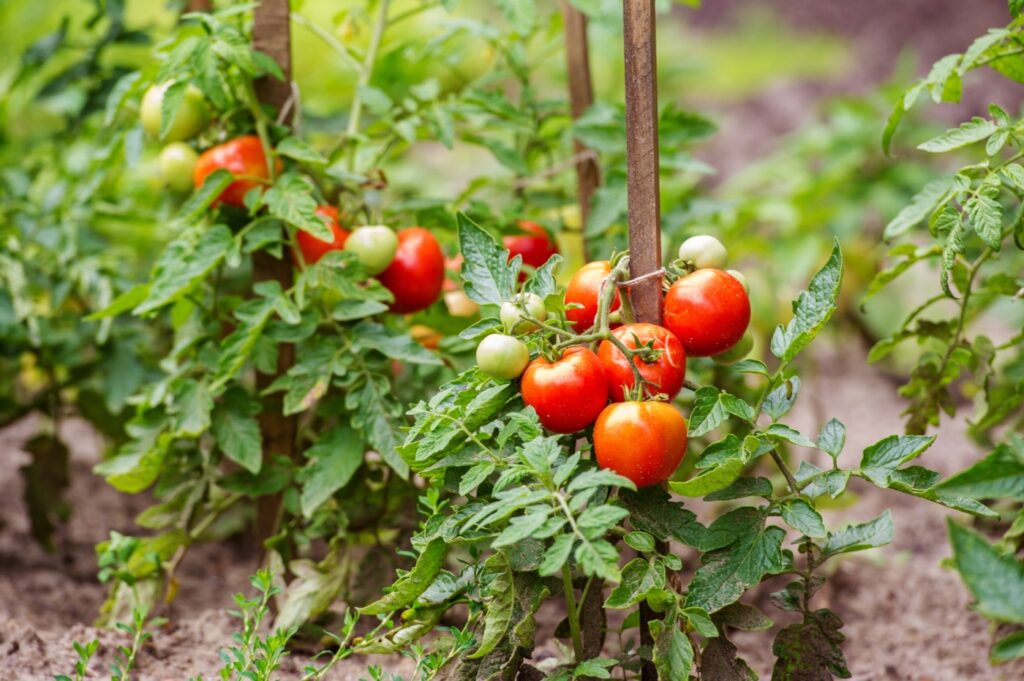
Q: My indeterminate tomato plants will stop producing as soon as the weather gets hot, then they dry up and die. What can I do to ensure that they produce through the summer?
A: For either determinate or indeterminate tomato varieties, high temperatures can adversely affect fruit production. After only a few days of daytime high temperatures of 85 F or higher, accompanied by nighttime temperatures of 70 F or higher, a tomato plant will drop all its flowers. When daytime temperatures reach 95 F, tomatoes will stop growing and if the nighttime temperatures stay above 85F, the fruit will not ripen. Needless to say, they really don’t like temperatures over 100 F.
Since the plants stop growing at high temperatures, they may not need as much water as during their growth phase. Of course, you want to make sure that they don’t dry out but be careful not to overwater.
We like to use grass clippings as mulch in the vegetable garden, since this protects shallow roots, maintains soil moisture, and suppresses weeds. The grass clippings dry quickly when spread out and break down nicely by the end of the growing season.
We’ve found that our tomatoes are especially susceptible to spider mites and white fly during the hottest part of the summer. Removing the dead, lower branches and cleaning up leaf litter under the plants helps substantially.
Once the weather cools off, most areas will stay frost-free long enough for those tomatoes to produce a smaller (yet still delicious) fall crop.
Q: I have 2 hibiscus plants in front of my house. Until a few weeks ago, they both seemed very healthy. But one of them appears to be dying. I would appreciate any help that you can provide.
A: One of your plants does indeed look very healthy. The other one is losing its leaves, and the leaves that are left are either shriveled or curled. Both plants are in large pots that look like they are either made of terra cotta or concrete.
I noticed that the soil in the pot containing the yellow plant looks quite wet. Since you didn’t mention the presence of any insects, my first guess is that the problem pot is waterlogged. Most pots have drainage holes that are too small or no drainage holes at all. Sometimes the drainage hole becomes clogged, and water will accumulate until the plant drowns. This doesn’t take very long, and once a plant has root rot it is usually not salvageable.
Another problem may be that the drain holes are fine, but the pot is resting directly on concrete or some other impermeable surface. Water drains through the hole but is trapped under the pot.
I would recommend dumping the entire contents of the problem container, including the soggy soil. If the soil smells bad, you’ll know that the plant’s roots have probably rotted. This soil should be fine for digging into your garden, but I wouldn’t recycle it into another container.
Looking for more gardening tips? Here’s how to contact the Master Gardener program in your area.
Los Angeles County
mglosangeleshelpline@ucdavis.edu; 626-586-1988; http://celosangeles.ucanr.edu/UC_Master_Gardener_Program/
Orange County
ucceocmghotline@ucanr.edu; 949-809-9760; http://mgorange.ucanr.edu/
Riverside County
anrmgriverside@ucanr.edu; 951-683-6491 ext. 231; https://ucanr.edu/sites/RiversideMG/
San Bernardino County
mgsanbern@ucanr.edu; 909-387-2182; http://mgsb.ucanr.edu/
